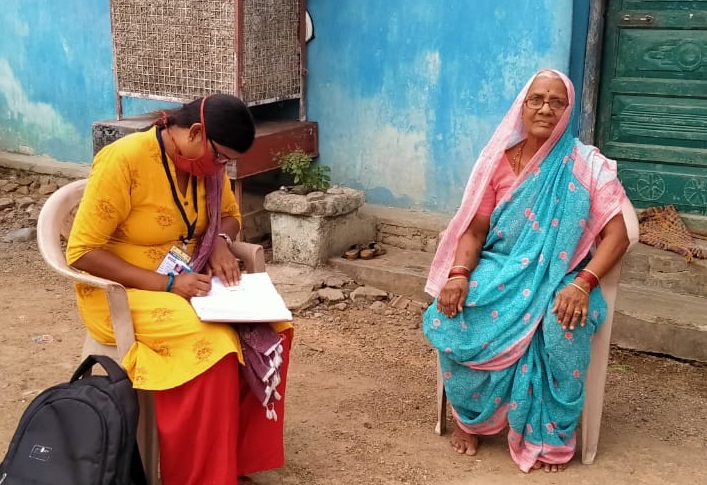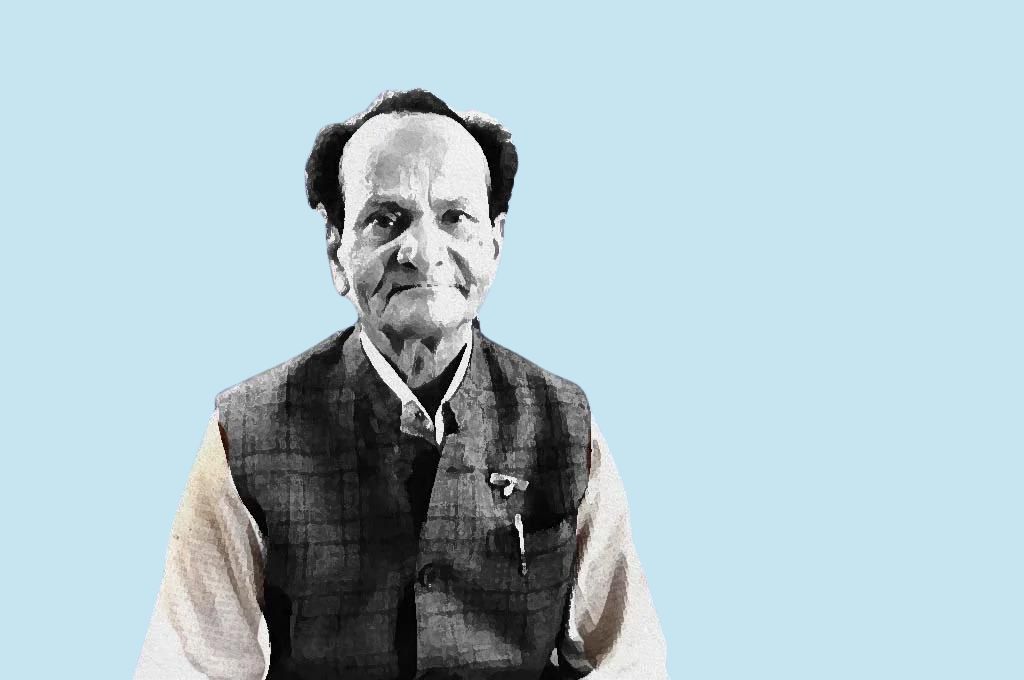Sitabai is a 66-year-old woman from Kalamna village of Ballarpur, Chandrapur district, Maharashtra and lives with her only son. She suffers from hypertension and diabetes. Before the pandemic, she used to be regular with her health check-ups and medications.
“Although my sugar levels have been persistently high over the last few months and the primary health centre (PHC) doctor asked me to go to the rural hospital, I do not want to go. What if I catch the [COVID-19] infection?” says Sitabai.
Reverse migration has led to an increased risk of exposure to the virus, especially among those in the higher age groups.
Just like Sitabai, there are many elders—people above the age of 60—living in rural India who have been affected by the pandemic, the nationwide lockdown, and physical distancing norms. Additionally, reverse migration has led to an increased risk of exposure to the virus among rural communities, especially among those in the higher age groups. Over the last few months, we have observed that COVID-19 has made elderly citizens fearful and anxious for a number of reasons:
- News identifying elders as a vulnerable group
- Limited mobility due to non-availability of transport
- Anxiety about family members
- Absence of friends and families
- Loss of employment
Increased vulnerability
According to the Government of India’s COVID-19 mortality data (till October 13, 2020), 53 percent of deaths have taken place in the age group of 60 years and above; 35 percent between the age group of 45-60 years; and only 10 percent in the 26-44 years age group. Additionally, another set of data showed that among the age group of 60 years and above, 24.6 percent of overall deaths have exhibited comorbidities related to diabetes, chronic kidney issues, hypertension, and heart-related problems, while only 4.8 percent didn’t have any underlying health issues.
With age, their immune system is also compromised, making them more vulnerable to infections such as COVID-19.
As per the Census 2011, there are nearly 104 million elderly persons (aged 60 years or above), with 71 percent of this elderly population residing in rural areas. Looking at this data, it is clear that the elderly—especially the rural elderly—who live with comorbidities need more attention and regular medication to combat the situation. With age, their immune systems are also compromised, making them more vulnerable to infections such as COVID-19.
Given this, we have seen a renewed focus on addressing the health needs of the elderly in rural areas over the last few months. At Tata Trusts (where I work) this is being done by operationalising the Government of India’s National Programme for Health Care of Elderly (NPHCE), in collaboration with the state and district administrations, the public health departments, and the gram panchayats in Chandrapur district of Maharashtra, Medak district of Telangana, and Yadgir district of Karnataka. As part of this, we have been connecting the elderly to government medical staff, such as ANMs and ASHAs for providing medications, and gram panchayat field volunteers for providing pensions, groceries, and essential goods at their doorsteps.

Since the lockdown, our field teams have also reached out to more than 25,000 elders through outbound calls to understand their needs and well-being. | Picture courtesy: Piyush Khanorkar
Since the lockdown, our field teams have also reached out to more than 25,000 elders through outbound calls to understand their needs and well-being. These calls have helped us understand some of the challenges currently faced by the rural elderly and to identify potential solutions.
Empirical evidence, based on our work done in the three rural districts of Maharashtra and Karnataka, suggests that the elderly suffer from multiple chronic illnesses, such as diabetes, hypertension, arthritis, and visual and hearing problems. As a result of decreased frequency of public transport owing to the lockdown, around 31 percent and 28 percent of the elderly surveyed could not access routine medication and public healthcare facilities, respectively.
Access to both has improved over time, and the figures currently stand at around 11.2 percent and 10.2 percent, respectively. Additionally, physical distancing measures have kept caregivers away from bedridden elders, and untrained family members are finding it difficult to replace caregivers. Moreover, the stigma of getting tested positive, and ignorance and myths around the pandemic and its transmission, are affecting the mental health of the elderly.
As per government data, 66 percent of elderly men and 23 percent of elderly women in rural areas are engaged in income-generating activities. Between April and August this year, nearly eight percent of the elders who worked in farms and as daily wage labourers in the three geographies we surveyed, lost their source of income. Twenty-five percent also indicated that they need financial support. The lockdown coincided with the harvesting season, and the harvest of crops such as wheat, paddy, barley, and seasonal vegetables and fruits was put on hold.
Because of mobility restrictions, elders could not go to banks to collect cash and the ones who received pensions had a hard time collecting their funds. This was primarily observed in those households where the elderly are the sole breadwinners.
The prices of essential goods rose during the pandemic, due to limited supply. In line with this, our study noted that the financial crisis limited the purchasing capacity of essentials such as vegetables, fruits, milk, and other regular grocery items. Almost 19 percent of the elders surveyed stated that the public distribution system provided only grains, and standing in long queues was unbearable.
Through the outbound calls, we learnt that almost 40 percent of the elders expressed that they were feeling lonely due to the lockdown as they couldn’t meet their friends or go to places of worship, and social interactions had been hampered.
Most of the rural elders who lived alone did not have a smartphone.
With the rise in COVID-19 cases, and news around natural disasters, such as cyclone Nisarga, they have also been increasingly worried for distantly located family members and friends. Our study further noted that most of the rural elders who lived alone did not have a smartphone, thus connecting virtually was not an option for them.
More can be done for the rural elderly
While challenges abound, there are many things we can be doing for the rural elderly to mitigate these negative impacts.
It is important that the community—more specifically, younger people in villages—rise to the challenge and come together to dispel any misgivings that the elders may have. As part of this:
- Panchayati Raj Institutions (PRIs) can maintain groups of volunteers for such emergencies.
- Elders in need can be provided with midday meals to ensure nutrition and good health.
- Communities can help make medicines and medical check-up accessible by encouraging last-mile delivery. Youth or National Service Scheme (NSS) and National Cadet Corps (NCC) volunteers can be trained as swasthya sevaks to support frontline health workers. They can assist the elders in their communities—especially those with mobility issues—by providing medications and basic health counselling at their doorsteps.
- Self-help groups (SHGs) for elders must be encouraged, to discuss and tackle issues with the support of the gram panchayat.
- To reduce financial dependency, skill development for non-farm livelihoods can take place, where elders are taught alternative livelihood options, such as making bamboo products, quilts, or pottery.
State governments can explore the following initiatives:
- Telemedicine: In the long run, telemedicine infrastructure can be integrated into public primary health facilities. This shall reduce direct and indirect medical expenditure, and help elders access consultations near their doorsteps.
- Self-care management for common diseases: Frontline health workers can be trained to teach elders how they should care for themselves and how lifestyle modifications can keep common diseases at bay or in control. This training can be expanded for caregivers too.
- Psychological first-aid training: Frontline health workers should be trained to help in identifying elders in distress, communicating effectively, and providing coping measures or referrals to advanced health facilities.
- Digital literacy: Social isolation and not being able to connect with distant family members has caused a lot of distress among the rural elderly. In response to this, digital literacy drives may be proposed and executed, in order to empower the elderly to use digital banking, telemedicine consultations, and e-social engagements. Central and state governments can provide devices and create a cadre of sevaks to teach seniors and empower them. Networks, such as Internet Saathi, and programmes, such as Swastha Bharat Preraks and Zila Swachh Bharat Preraks, which already have huge network bases, can be leveraged.
- National helpline for senior citizens: A toll-free active helpline is needed for addressing elderly issues and connecting them to concerned facilities for redressal.
The pandemic has affected everyone across the board, but the rural elderly have been impacted uniquely. A clear reassuring message to elders that they will be cared for by their families, local communities, and administrations will relieve them of stress related to this pandemic, especially, in the remote rural geographies of this country.
—
Know more
- Learn about the realities of being a senior citizen in India during COVID-19.
- Read about how various individuals and organisations stepped up to help senior citizens during the pandemic.
Do more
- Read and share the Ministry of Health and Family Welfare’s health advisory on steps we can take to reduce the transmission of COVID-19 among the elderly.
- Learn more about how you can provide support and care for senior citizens during the pandemic.




